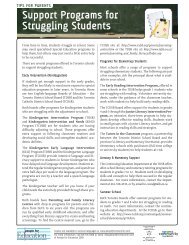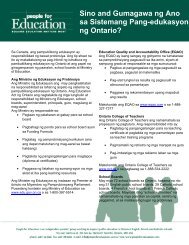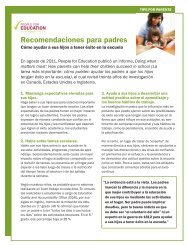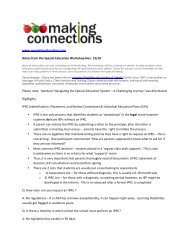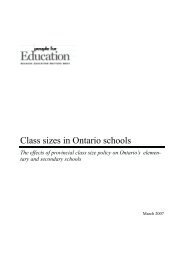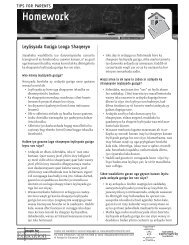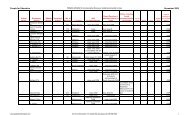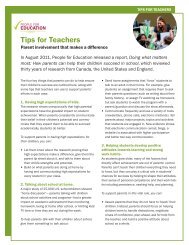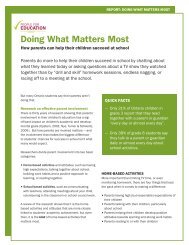Our Children Our Future Our Vision - People for Education
Our Children Our Future Our Vision - People for Education
Our Children Our Future Our Vision - People for Education
You also want an ePaper? Increase the reach of your titles
YUMPU automatically turns print PDFs into web optimized ePapers that Google loves.
<strong>Our</strong> <strong>Children</strong>, <strong>Our</strong> <strong>Future</strong>, <strong>Our</strong> <strong>Vision</strong><br />
(a) Socio-Economic Conditions<br />
“<strong>Our</strong> kids are suffering – which [puts a] strain on family relationships<br />
and affects well-being in community” (Student)<br />
The deplorable socio-economic conditions of many First Nations in Canada have been described<br />
as a “national disgrace” 71 and a “national shame”. 72 These preventable social conditions are not<br />
only an international embarrassment to Canada, but the maintenance of these conditions through<br />
federal Indian policy and the purposeful, chronic underfunding is a violation of our most basic<br />
human rights. While not all First Nations share the same socio-economic conditions, the national<br />
statistics are startling and represent an absolutely intolerable way of life <strong>for</strong> our people. 73<br />
According to the 2006 Census, there are 698,025 First Nations individuals in Canada which includes<br />
564,870 registered (status) Indians and 133,155 non-registered (non-status) individuals. 74 While this<br />
number will be affected slightly by the new registrations due to the Bill C-3 amendments to the<br />
Indian Act in 2011, these new additions are expected to be relatively low. 75 The province of Ontario<br />
is home to the largest Aboriginal population in Canada with 296,495 Aboriginal residents. 76 There<br />
are 133 First Nations in Ontario with an approximate population of 191,721. 77<br />
The statistics are quite alarming on almost all First Nation socio-economic indicators. The statistics<br />
71 Office of the Correctional Investigator, “Annual Report of the Office of the Correctional Investigator” (years 2000-2010<br />
inclusive), online: OCI [OCI Report 2000] to [OCI Report 2010] inclusive.<br />
72 L. Eggerton, “Physicians challenge Canada to make children, youth a priority” (2007) 176 vol.12 Canadian Medical<br />
Association Journal 1693 [Physician’s Challenge] at page 1 where <strong>for</strong>mer Lieutenant Governor James Bartleman<br />
calls the situation a “national shame”.<br />
73 Death by Poverty, supra note 52 at 3-4.<br />
74 Statistics Canada, “2006 Census: Aboriginal <strong>People</strong>s in Canada in 2006: Inuit, Métis and First Nations, 2006 Census:<br />
Highlights” (Ottawa: Statistics Canada, 2006), online: Statistics Canada <br />
[2006 Census]. The Census includes North American Indians or First Nations<br />
(both registered and unregistered), Metis and Inuit in that definition. It is also important to note that this report<br />
focuses on the Aboriginal identity statistics. Statistics Canada makes a distinction between those with Aboriginal<br />
identity and those who report Aboriginal ancestry: “Aboriginal identity refers to those persons who reported identifying<br />
with at least one Aboriginal group, that is, North American Indian, Métis or Inuit, and/or those who reported<br />
being a Treaty Indian or a Registered Indian, as defined by the Indian Act of Canada, and/or those who reported they<br />
were members of an Indian band or First Nation.” Aboriginal ancestry, on the other hand, is defined as referring to:<br />
“the ethnic or cultural origin of a person’s ancestors, an ancestor being usually more distant than a grandparent.<br />
In the census, if a person reports at least one Aboriginal ancestry response, the person is counted in the Aboriginal<br />
ancestry population.” See also: Aboriginal Affairs and Northern Development Canada, “First Nations <strong>People</strong> of<br />
Canada”, online: [First Nations]. AAAANDC reports that there<br />
are: “704,851 First Nations people in Canada. Most First Nations people – 403,369 (57%) – live in First Nations communities<br />
which are also called “reserves.” The other 301,514 (43%) live mainly in the larger cities.”<br />
75 Bill C-3 An Act to promote gender equity in Indian registration by responding to the Court of Appeal <strong>for</strong> British<br />
Columbia decision in McIvor v. Canada (Registrar of Indian and Northern Affairs) R.S.C. 2010 c.18 [Bill C-3]. See also:<br />
M. Hurley, Library of Parliament “Legislative Summary of Bill C-3: Gender Equity in Indian Registration Act” (Ottawa:<br />
Library of Parliament, 2010), online: [C-3 Summary]. Beyond Blood, supra note 16. Discussions<br />
with Indian Affairs employees have revealed that far less qualify than expected, despite the unexpectedly<br />
high number of applications which have created a backlog in processing.<br />
76 Ontario Ministry of Aboriginal Affairs, “Aboriginal <strong>People</strong> in Ontario”, online: [Aboriginal <strong>People</strong>].<br />
77 Ibid.<br />
Chiefs of Ontario<br />
16



